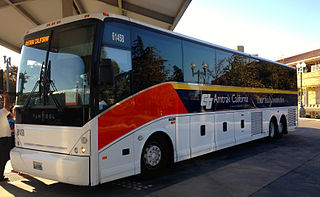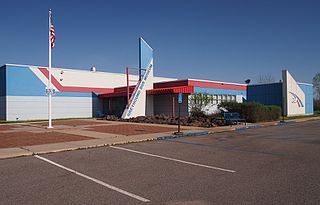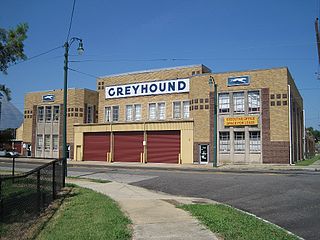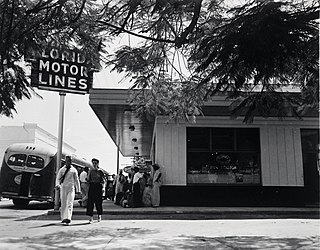Related Research Articles

Greyhound Lines, Inc. (Greyhound) is a company that operates the largest intercity bus service in North America. Services include Greyhound Mexico, charter bus services, and Amtrak Thruway services. Greyhound operates 1,700 coaches produced mainly by Motor Coach Industries and Prevost serving 230 stations and 1,700 destinations. The company's first route began in Hibbing, Minnesota in 1914 and the company adopted the Greyhound name in 1929. The company is owned by Flix North America, Inc., an affiliate of FlixBus, and is based in Downtown Dallas.

The Trailways Transportation System is a public transport bus service in the United States. It operates as network of approximately 70 independent bus companies. The company is headquartered in Fairfax, Virginia.

Amtrak Thruway is a system of through-ticketed transportation services to connect passengers with areas not served by Amtrak trains. In most cases these are dedicated motorcoach routes, but can also be non-dedicated intercity bus services, transit buses, vans, taxis, ferry boats and commuter rail trains.

Peter Pan Bus Lines operates an intercity bus service in the Northeastern United States. It is headquartered in Springfield, Massachusetts.

Greyhound Canada Transportation ULC began as a local British Columbia bus line in the early 1920s, expanded across most of Canada, and became a subsidiary of the US Greyhound in 1940.

Viad Corp provides experiential leisure travel and face-to-face events in the United States, Canada, the United Kingdom, Europe, and the United Arab Emirates via two divisions: GES and Pursuit.

Trailways of New York is one of the largest privately held transportation companies based in New York State. It employs over 450 people and carries passengers more than 80 million miles annually.
Northern Virginia is part of the Washington Metropolitan Area of the United States, and its surface transit system is integrated with that of the city of Washington, D.C. However, because of the Potomac River separating Northern Virginia from the city, the two systems have evolved largely independently. At present, most major bus routes, including all that cross the Potomac, are operated by the Washington Metropolitan Area Transit Authority (WMATA), while several smaller systems are city- or county-owned. Since the Washington Metro opened to Virginia, most of the bus routes have terminated on either side of the Potomac River, where passengers can transfer to the rapid transit system, or to one of the few WMATA Metrobus routes that cross the river.

The Greyhound Bus Museum is located in Hibbing, Minnesota, United States, where Carl Wickman and Andrew "Bus Andy" Anderson started their first bus service in 1914 transporting fellow miners in a 1914 Hupmobile.
The Great Lakes Greyhound Lines, a highway-coach carrier, was a Greyhound regional operating company, based in Detroit, Michigan, USA, from 1941 until 1957, when it merged with the Northland Greyhound Lines, a neighboring operating company, thereby forming the Central Division of The Greyhound Corporation, called also the Central Greyhound Lines.
The Tennessee Coach Company (TCC) was a regional highway-coach carrier, founded in 1928 and based in Knoxville, Tennessee, USA. It was in operation until 1976, when it became merged into the Continental Tennessee Lines, a subsidiary of the Transcontinental Bus System, called also the Continental Trailways. Continental Trailways was by far the largest member company in the Trailways trade association, which was then named the National Trailways Bus System.
The Southeastern Greyhound Lines, a highway-coach carrier, was a Greyhound regional operating company, based in Lexington, Kentucky, USA, from 1931 until 1960, when it became merged with the Atlantic Greyhound Lines, a neighboring operating company, thereby forming the Southern Division of The Greyhound Corporation, called also the Southern Greyhound Lines.

The Dixie Greyhound Lines, a highway-coach carrier, was a Greyhound regional operating company, based in Memphis, Tennessee, USA, from 1930 until 1954, when it became merged into the Southeastern Greyhound Lines, a neighboring operating company.
The Teche Greyhound Lines, a highway-coach carrier, was a Greyhound regional operating company, based in New Orleans, Louisiana, USA, from 1934 until 1954, when it was merged into the Southeastern Greyhound Lines, a neighboring operating company.

The Florida Greyhound Lines, a highway-coach carrier, was a Greyhound regional operating company, based in Jacksonville, Florida, USA, from 1946 until 1957, when it was merged into the Southeastern Greyhound Lines, a neighboring operating company.
The Atlantic Greyhound Lines, a highway-coach carrier, was a Greyhound regional operating company, based in Charleston, West Virginia, USA, from 1931 until 1960, when it became merged with the Southeastern Greyhound Lines, a neighboring operating company, thus forming the Southern Division of The Greyhound Corporation, which division became called also the Southern Greyhound Lines (GL).
Central Greyhound Lines is a name used in six different contexts or applications in the intercity highway-coach industry in the USA. In each of the first five instances, the name was used for a regional operating company of The Greyhound Corporation. In the last instance, the name was used for an internal administrative department of the (second) Greyhound Lines, Inc., the (second) GLI, a separate, independent, unrelated firm, after the GLI bought the core bus business of The Greyhound Corporation.
The New England Greyhound Lines, an intercity highway-coach carrier, was a Greyhound regional operating company, based in Boston, Massachusetts, USA, from 1937 until 1955, when it became a part of the Eastern Division of The Greyhound Corporation (called also the Eastern Greyhound Lines, the first of four huge new divisions.

Martz Group is a bus company headquartered in Wilkes-Barre, Pennsylvania, operating intercity commuter buses, charter buses, and tours. Martz is a part of the Trailways Transportation System, a network of approximately 70 independent bus companies. Martz Group operates Martz Trailways, which provides intercity commuter bus service from the Wyoming Valley cities of Wilkes-Barre and Scranton and the Pocono Mountains in Northeastern Pennsylvania to New York City and Philadelphia. Martz Group operates the Gold Line commuter service and Gray Line sightseeing service in Washington, D.C.. Martz operates the National Coach Works in Virginia, and the First Class Coach Company Trailways serving Tampa and St. Petersburg in Florida. Martz Bus operates two Amtrak Thruway Connecting Service lines is Florida and Pennsylvania. Martz Group also uoffers interstate and intrastate charter bus services.
References
- Jackson, Carlton (1984). Hounds of the Road. Dubuque: Kendall Hunt Publishing Company. ISBN 0-87972-270-3.
- Meier, Albert, and John Hoschek (1975). Over the Road. Upper Montclair, NJ (US): Motor Bus Society. No ISBN.
- Schisgall, Oscar (1985). The Greyhound Story. Chicago: J.G. Ferguson Publishing Company. ISBN 0-385-19690-3.
- Motor Coach Age (a publication of the Motor Bus Society), various issues, especially these:
- September 1979;
- October 1979;
- July 1984;
- October–December 1998;
- October–December 1999.
- Jon's Trailways History Corner, a web-based Trailways history by Jan Hobijn (also known as Jon Hobein) at http://cw42.tripod.com/Jon.html.
- Web-based schedules and historical data at https://web.archive.org/web/20060312191347/http://www.greyhound.com/.